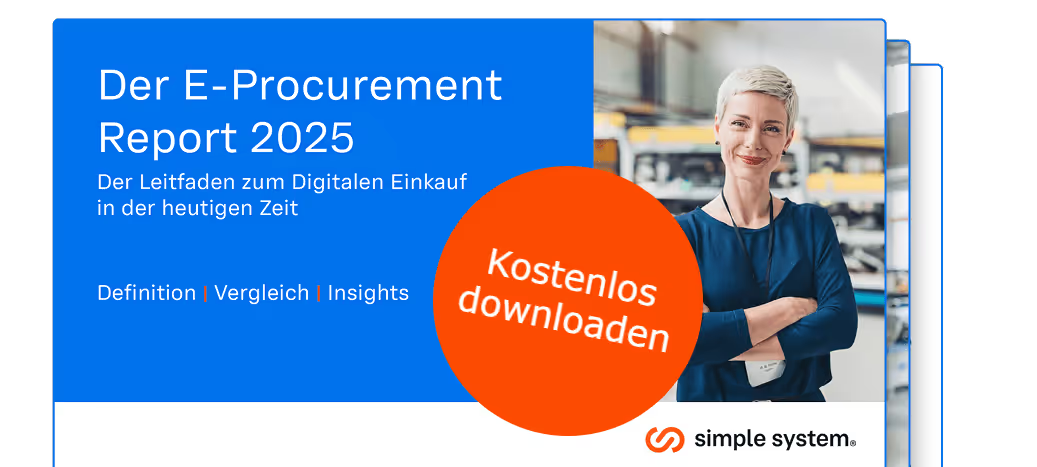E-procurement simplifies procurement through electronic systems. It offers cost savings, efficiency improvements, and improved transparency. Future trends include AI, big data, blockchain and sustainability in the procurement process.
E-procurement - Electronic procurement explained in simple terms.
E-procurement, or electronic procurement, describes the simplification of the procurement process through the use of electronic systems and technologies. This fast-growing concept, has transformed the way companies manage their purchasing activities, making them easier, more efficient, and less expensive.
In this article, we'll dive into the world of e-procurement and explore its benefits, implementation strategies, and key tools and technologies.
Definition: What is e-procurement?
E-procurement is the electronic procurement process that enables the purchase of goods and services via the Internet. Companies can automate their procurement processes and make them more efficient, by using electronic systems for ordering, delivery, and billing. Overall, e-procurement enables more efficient and cost-effective procurement of goods and services.

What are the benefits of the electronic procurement process?
Digitalization is not always accompanied by obvious advantages. It is not enough to transfer a process to software and the Internet; this process must create clear added value for users. In procurement, the advantages are numerous and can result in decisive competitive advantages.

Cost savings with more efficient procurement systems
- By automating ordering and billing processes for indirect demand, companies can reduce their costs. By using electronic systems, companies can automatically generate orders and process invoices efficiently. This results in a reduction in manual workload, and allows employees to focus on other important tasks.
- At the same time, human errors are minimized, leading to fewer incorrect orders and lower costs. In addition, the use of electronic catalogs enables better comparability of products and prices, which can lead to further cost savings.
- In addition, efficient supply chain planning and management enables savings in inventory costs. By closely monitoring orders and deliveries, companies can optimize inventory and reduce waste. This results in a reduction in inventory costs and a better use of capital.
Improved visibility and control
- Electronic document management is an important part of professional e-procurement systems. It enables seamless tracking of orders, deliveries and payments. By using electronic systems, companies can access up-to-date information on prices, availability and delivery times at any time. As a result, the transparency and control over the procurement process improved.
- In addition, through the integration of E-procurement solutions ensures seamless data consistency with other business systems. Companies can store all relevant information in a central system and access it flexibly. This not only makes it easier to search for specific documents, but also enables efficient communication with vendors and other internal departments.
- Another advantage of electronic document management, is electronic reporting. Companies can carry out detailed analyses of procurement activities and monitor important key figures. This enables them to identify trends, identify potential and continuously improve their procurement strategy.
Increased compliance and security
- Digital procurement allows companies to standardize their processes and thus better meet legal requirements. This allows them to comply with applicable laws and regulations and minimize potential risks. A clear role and authorization structure in e-procurement ensures controlled and comprehensible procurement. By assigning specific roles and access rights to their employees, companies can ensure that every order process is properly approved and documented. This improves control over procurement and reduces the risk of fraud or misuse.
- E-procurement also enables a improved compliance with internal policies and external regulations. Companies can integrate their own procurement policies into the electronic system and implement automatic reviews. This ensures that all orders and transactions meet the required standards and that potential violations can be identified and resolved at an early stage.
- Electronic archiving of documents in e-procurement increases data security and makes auditing easier. By storing all relevant information in an electronic system, companies can Control access to sensitive data and provide auditors with easy access to the information they need. This contributes to data security and makes it easier to comply with audit-related requirements.
Types of e-Procurement Systems
There are various types of e-procurement systems that companies can use to optimize their procurement processes. Each variant has its own advantages and disadvantages, which must be weighed up for the respective application.

Direct e-procurement
Through direct e-procurement, companies can make the procurement process more efficient and save costs. By interacting directly with vendors electronically, they can place orders faster and reduce delivery times. This allows companies to better manage their inventory and avoid bottlenecks. In addition, direct e-procurement enables a transparent and rapid exchange of information between purchasers and vendors.
By using electronic systems, companies can access up-to-date information on prices, availability and delivery times at any time and thus optimize their procurement decisions. Finally, electronic invoicing also simplifies the payment processing process.
Indirect e-procurement
An indirect e-procurement system provides access to a wide range of products and services from various providers. This allows companies to optimize their procurement processes by comparing prices and negotiating. The use of online marketplaces makes it easier to search for suitable vendors and products.
By using indirect electronic procurement can companies access a wide range of vendors, the companies to find the best products at the lowest prices, resulting in cost savings and better procurement results.
Catalog-based e-procurement systems
Catalog-based e-procurement enables purchasers to process their procurement orders based on predefined catalogs. By using electronic catalogs, companies can get quick and easy access to current product information, conditions, and prices. This feature makes the procurement process much easier, as companies can choose from a selection of pre-defined products.
Future prospects for the use of e-procurement
Artificial intelligence, big data and blockchain are topics that are causing disruption in many industries - including in purchasing. The procurement of the future will go through changes that should be implemented in a company as early as possible. However, while these developments are still under development, the issue of sustainability is more urgent than ever before.
Development of artificial intelligence and big data
By using advanced algorithms, companies can use artificial intelligence and Big Data make automated decisions to improve their procurement processes. These technologies enable companies to forecast procurement needs more precisely and thus better manage their inventories. By identifying trends and patterns in procurement, companies can reduce costs and increase efficiency.
In addition, the development of artificial intelligence also enables early identification of procurement risks and the introduction of appropriate measures to minimize risks. By using big data in e-procurement, companies also have the opportunity to better understand and optimize their vendors relationships. By collecting and analyzing large amounts of data, companies can gain important insights that help them achieve better negotiation conditions and improve collaboration with their vendors.
Integration of blockchain technology
The integration of blockchain technology in e-procurement enables secure management and verification of transactions without a central authority. As a result, the Reduced risk of fraud and manipulation in the procurement process. The decentralized nature of blockchain technology ensures that all transactions are transparent and traceable. Smart contracts on the blockchain enable automated and trustworthy transactions between purchasers and vendors. These smart contracts are stored on the blockchain and executed automatically as soon as the appropriate conditions are met. This minimizes human errors and improves the efficiency of the procurement process.
The integration of blockchain technology also offers the opportunity to track the entire life cycle of a supply chain and thus ensure greater transparency and traceability. By storing information about production locations, transportation routes, and quality controls on the blockchain, companies can ensure that their supply chains are sustainable and ethical. This creates trust among customers and promotes a long-term partnership between purchasers and vendors.
Focus on sustainability and CSR
An increased focus on sustainability in e-procurement aims to promote more environmentally friendly procurement practices. Companies can reduce their environmental footprint by choosing more sustainable products and vendors. These measures not only help protect the environment, but also strengthen the company's reputation.
CSR (Corporate Social Responsibility) in e-procurement includes ethical standards, social responsibility and transparent business practices. Companies that design their procurement processes in a sustainable and socially responsible way can strengthen their reputation as a trustworthy partner. Such a focus on sustainability and CSR can provide long-term competitive advantages as more and more customers value environmentally friendly and ethical business practices.
Conclusion
In summary, e-procurement is a powerful tool that offers companies numerous advantages. It enables cost savings through more efficient procurement processes, time savings through automated workflows, improved transparency and control, and increased compliance and security. In doing so, it paves the way for a more efficient, secure and sustainable future of supply chain management.

Einkaufen & sparen
Erfahren Sie, wie es geht, in unserem kostenlosen E-Procurement-Report. Jetzt kostenlos und unverbindlich herunterladen.
Jetzt lesen








